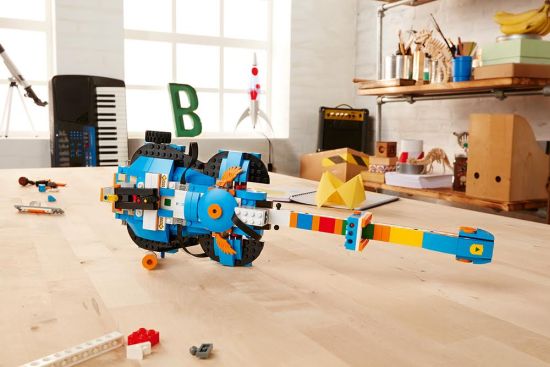
Four Things You Need to Know About Connected Toys

The power of a connected toy is how it can complement a child’s natural play behaviour. It’s not about breaking the mould of how children play, it’s about the potential of their creativity combined with technology.
Toys should be a tool that enable cognitive development through imaginative play. A well designed toy is adaptable, allowing a child’s play to branch out from its primary narrative or original purpose. This amplifies learning and growth, and more interest in the toy, meaning fewer one-day wonders discarded at the bottom of the toy chest.
This year Tech Crunch reported an increase in investment and Google searches for connected toys. They also predicted that the toys-to-life model seen in Skylanders will ‘create the first new billion-dollar revenue company in the connected toy category’. And with wareable.com and wired both listing the likes of Disney’s Playmation as the toys to watch, what could knock them off their perch?
What connected toys do well - building skills
Some connected toys are mirroring the successful and lucrative open-ended play format that’s found in products such as Lego and Play-Doh. These toys use making, skill building, rule breaking and inventive use of imagination to be entertaining and fun, whilst playing a role in cognitive development.
The past few years have seen a range of smart kits released to the market that nurture skills in building and making, some even finding their way into the classroom. Sam Labs use wirelessly activated building blocks containing sensors, switches and motors. Paired with an intuitive app, they let you create anything from remote control cars to musical instruments.
Lego Mindstorms is a kit similar to Sam Labs, but combined with their Lego Technics bricks. And Brixo, a kickstarter offering chrome-plated Lego-compatible bricks and motors, creates circuits that produce light or movement.
Kano’s new camera, pixel and speaker kits are an extension of their original computer kit that you can build and code, which also allows budding programmers to hack Minecraft.
These elements of coding and making are skills we should be encouraging. A recent PwC survey highlighted that 78% of IT leaders see a tech skills shortage in the UK. Providing our children with the building blocks of technology and code, like the BBC Micro:bit foundation, creates a form of play that has imagination and learning at its core.
What they don't do yet - spontaneous and free play
Smart toys such as interactive dolls that learn and evolve as your child develops have been criticised for not effectively helping cognitive development through play. These kind of toys have yet to gain significant recognition as a tool for child development when compared to their more basic counterparts.
The idea of giving such devices to children in early stages of development has also been rightly questioned. The focus for connected smart toys is much better placed on children who are at the stage of development where learning through work is appropriate.
Toy makers should consider what the need for connected capability is for those that play with them. Smart dolls aren’t going to replace the humble teddy bear for toddlers any time soon.
So why is this particular kind of connected toy proving to be the popular, and expensive, Christmas gift of choice? As well as their novelty aspect, we engage with them because we empathise with their sounds and physical gestures. This kind of empathy has been used in smart toys for as long as it’s been possible to build them. Robosapien was designed to show character by doing everything from dancing to farting, which funnily enough, kids loved. Experiments by Kate Darling at MIT, have shown that people will bond with toys that display lifelike characteristics or have back-stories, to the point that we even refuse to do them harm.
They’re not just for kids
Who said that children should get all the fun? The tech inside connected toys is no different to what’s being used in our everyday environment in this connected age. That’s why in the R/GA London office we use modular kits to prototype ideas for connected spaces and products. They’re simple and quick to use, allowing us to try out ideas for clients and ourselves.
Other forms of play for older demographics are also being disrupted by connected technology. I spoke to Nathan Miller from Hyper Island, a board game collector who describes how games can also follow divergence from narrative or primary purpose, and that technology is being used to augment the board game experience:
“XCOM the Board Game and Descent: Road to Legend use iPad apps as an AI opponent, so there is no need for anyone playing the game to take the part of Dungeon Master, or game organiser. Another example is Mask of Anubis, the first Virtual Reality board game.”
How has the use of technology been received by board game fans?
“In the past, technology has been met with skepticism over fears that games reliant on VHS or DVD would become outdated. Technological additions to board games need to be as futureproof as possible.”
And what about the experiences created by adding connectivity?
“Where technology has created new types of experiences in board games, players have found excitement in them. Virtual Reality and Artificial Intelligence will succeed in games if they make playful, physical experiences that use things like the body language and timbre of other players.”
It’s only the beginning
The ability to connect toys to mobile phones and other devices like games consoles, shows how manufacturers and brands such as Disney can have direct, measurable and, from their perspective, meaningful communication with the end users of their products.
It enables them to send anything from movie trailers and promotions of new products, to new ways of playing with the toys to keep them interested. This form of communication is likely to mature as brands find new and innovative ways to engage using connected toys.
The use of apps by children to consume content can place connected toys in the realms of passive forms of entertainment, such as watching videos, that don’t allow unstructured playtime. Yet toys such as the Yibu concept from frogLab, may show how this can be rebalanced. Its wooden toys with sensors emphasise active play, rather than focusing too much on the accompanying app.
At CES 2017 Lego announced it’s new Boost Creative Toolbox, released this autumn. With a free tablet app, the kit has parts to build and code five different connected models. From a cat that needs care and attention like a Tamagotchi, to a guitar that you can learn to play. But most interesting is the AutoBuilder model, a 3D printer that can produce real miniature Lego models.

Something else to watch out for is Magic Leap, the mixed reality startup that has raised around $1.5bn in funding and recently announced a partnership with Disney’s Lucasfilm. Its promising teasers show great potential: from whales breaching a gym floor and splashing back into the sea or a tiny elephant in the hand of a child, to a shoot-’em-up computer game played with robots crashing into the player’s living space.
It will be interesting to see how Magic Leap and toymakers harness the right mix of unstructured play, imagination and technology. Because the real magic lies in putting these tools into the hands of children, setting them free and seeing what they can do.













